Deaths in Australia
In Australia and a number of other countries prompt border closures: international, interstate; intercity; and occasionally intracity; with the closure of social venues; imposed social distancing; mask mandates; and occasional harsher lockdowns; kept the virus largely at bay so that in many places, for months on end, life went on largely as normal, while looking forward to the availability of an effective vaccine.
A contact tracing app was developed and was widely distributed but proved ineffectual. This was soon replaced by compulsory QR code (or manual) registration, before entry to indoor venues like: bars and cinemas; sporting venues and all retailers.
But as the second year approached the Australian National Cabinet (the intergovernmental decision-making forum composed of the prime minister and state and territory premiers and chief ministers - set up to manage the pandemic) decided that: with over 90% of the adult population vaccinated, it was time to end economically damaging lock-downs.
In doing so, they have accepted that this will inevitably result in an increasing number of pandemic deaths.
So now the numbers are rising the media have a new news story: 'If it bleeds - it leads'
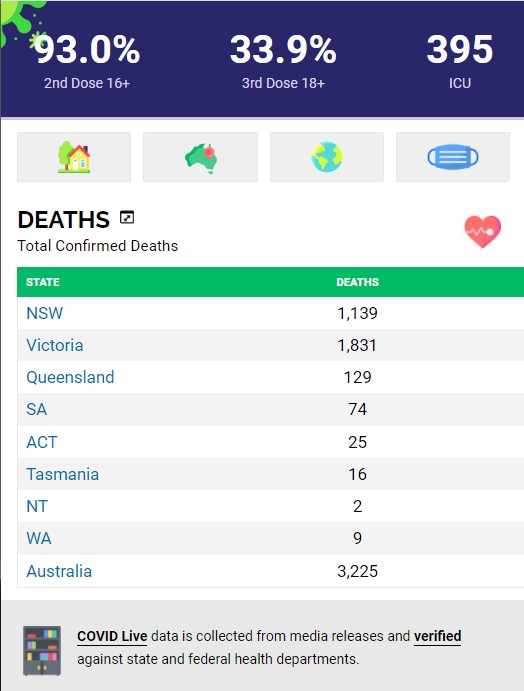 https://covidlive.com.au/report/deaths
https://covidlive.com.au/report/deaths
Covid-deaths are in the news in Australia, so I went to the Australian Bureau of Statistics (ABS) website for some perspective.
In a typical year 150 to 170 thousand people die Australia wide. The top five leading causes of death are Ischaemic heart disease, Dementia including Alzheimer's disease, Cerebrovascular diseases, Lung cancer and Chronic lower respiratory diseases.
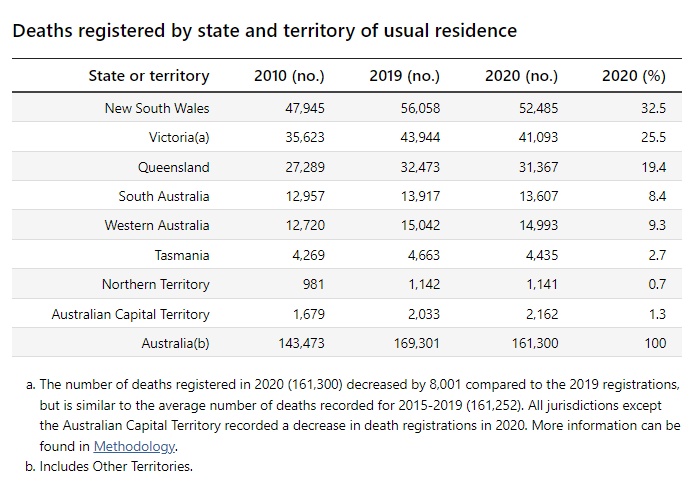
Covid-19 was well down the list. In 2020 it was the 38th most common. And of the Covid-19 deaths, around three quarters of those who died also suffered from other life-threatening conditions, in particular old age.
Deaths (all causes) by age and sex
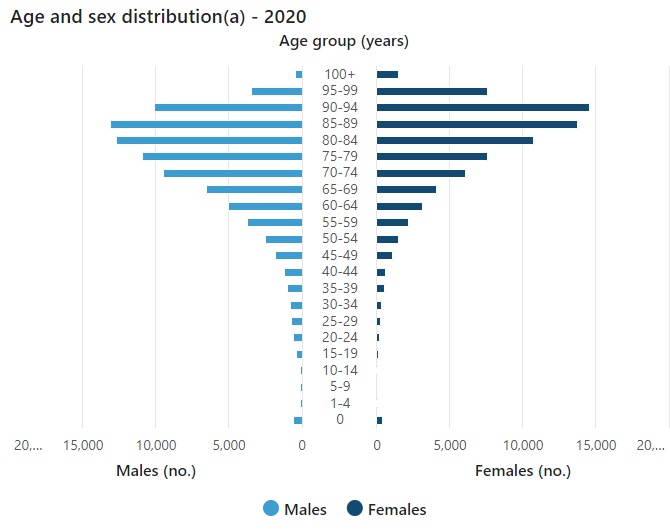
According to the ABS he unvaccinated CFR (case fatality rate) in Australia (that is, of those who catch the disease what percentage can be expected to die) for Covid-19 as of 31 July 2021 (Delta variant) was 2.7%. But as the chart below indicates CFR rises dramatically with age.
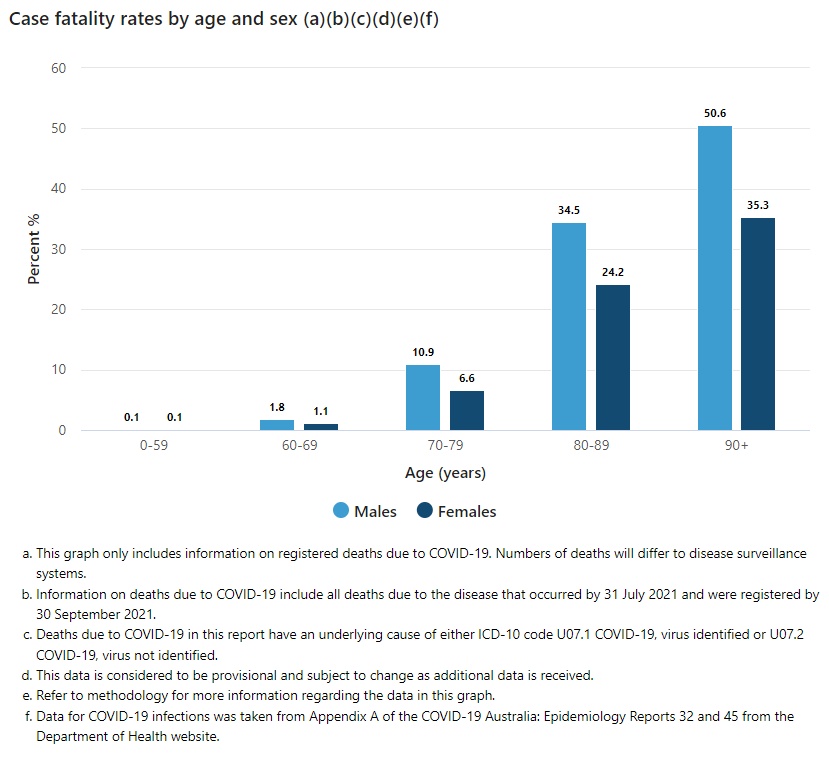
Thus, a still-unvaccinated man over 80 who catches Covid-19 has a better than 30% chance of dying. Buy a revolver - Russian-Roulette (CFR 17%) is a much better bet than remaining unvaccinated - and quicker.
Back in 1918 the Spanish Influenza that had an estimated CFR of around 2.5% (Taubenberger and Morens) so without vaccination we could expect a similar number of deaths, until the virus played itself out (through a combination of herd immunity and evolutionary pressure). In some ways the Spanish Influenza was worse than Covid-19. It impacted young adults to a much greater degree and back then there were a smaller percentage of people over the age of 60 to be killed (they were dead already). Within a few months in 1919 an estimated 15,000 Australians had died of Influenza.
Australia's total population was just 5.3 million.
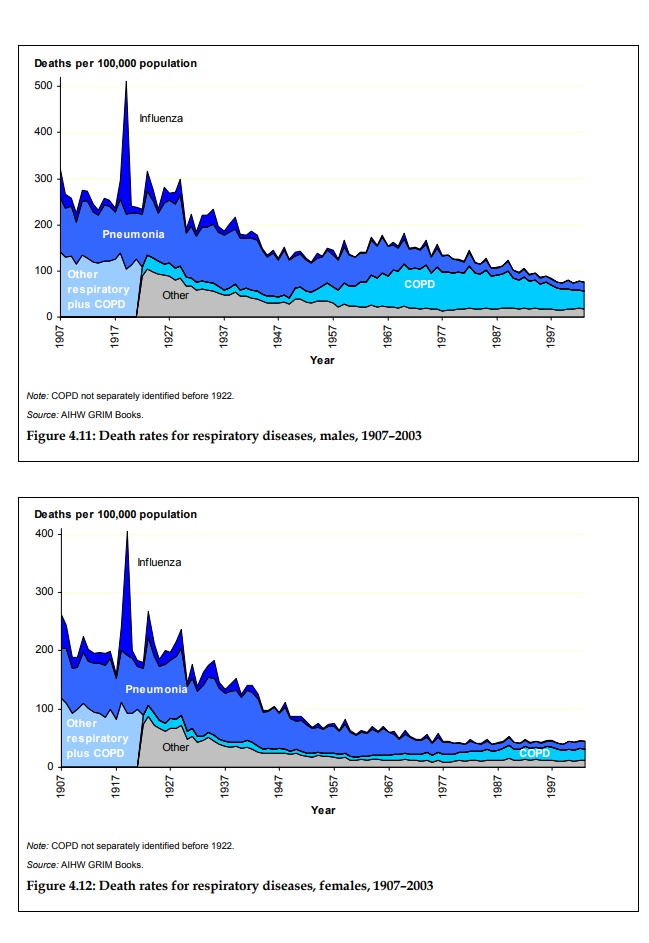
So, overall, will Covid-19 show up as a big spike in our deathrate when historians look back? The 1918-19 influenza pandemic certainly did.
This one will certainly show up as another big spike in the US and UK.
Well, no. When Victoria had their initial high deathrate, prior widespread vaccination, the ABS found that deaths in Victoria were lower than the long-term trend. The consequent hard lockdowns did as much to reduce other diseases that are potentially as deadly to the elderly, like influenza.
Well done, Victoria.
As the ABS reported for the whole of Australia in 2020:
"There was a 23.9% decrease in the age-standardised death rate from respiratory diseases.
Influenza and pneumonia mortality had the highest proportional rate decrease of all respiratory diseases with a drop of 45.8% from 2019.
There were 55 people who died from influenza. This compares to 1,080 in 2019.
Pneumonia is also a common terminal cause of death, especially for older people who have long term chronic conditions. There was a decrease of more than 20% in influenza and pneumonia as an associated cause of death (where it was not the underlying cause of death).
The decrease in the respiratory disease death rate from 2019 is the largest recorded over the last ten years."
Thus, pre-Covid, in New South Wales, an average of around 140 people died each day. Since 'opening-up' Covid-19 deaths are running at 32 per day (7-day average) but some of these would have died in any case due to underlying complications and others who may have died of respiratory disease may be hanging on. While any death is a tragedy for friends and family, at this stage it seems that the death rate is manageable, within the normally expected range.
So, historians will note that: in the first two years, Australia largely avoided the worst impact on life expectancy of the Covid-19 pandemic.
On the pandemic's second birthday, Australian society could, yet again, be congratulated on its cohesiveness, purpose and common sense in adversity. And perhaps our leaders, when they take advice from our Public Servants, aren't too bad after all?
Yet, we can have little sympathy for those younger ones who still refuse to get a couple of relatively harmless injections, putting themselves and others at risk, and end up in ICU or with long-term ill effects.
But the social and economic impacts of lock-downs and border closures and financial assistance were both immediate and long-term.
So, let's now concentrate on getting the economy up and running again to reduce the present burden's impact on future generations.
As I suggested at the outset: Love in the time of Coronavirus, after vaccination became the norm, herd immunity has become our best strategy: get vaccinated or get infected (and suffer the consequences). We no longer lockdown for the annual flue, nor should we.

